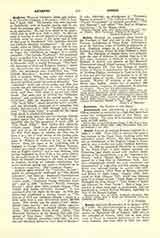

Anerio, FELICE, an eminent Roman composer, B. C. 1560; d. c. 1630. From 1575 he was for four years a boy-soprano in the Papal Choir, studying under the celebrated master Nanini. His first appointment was as choirmaster of the English College in Rome, and his next a similar one under Cardinal Aldobrandini. In 1594 he succeeded Palestrina as composer to the Papal Choir, a post created specially for Palestrina, and which ceased with Anerio’s death. Several of his compositions, e.g. an “Adoramus Te, Christe” and a “Stabat Mater“, for three choirs, passed for a long time as Palestrina’s work. Anerio’s compositions (which are very numerous) are characterized by originality and fine artistic feeling. Many were printed during the period 1585-1622. We may mention “First Book of Hymns, Canticles and Motets for eight voices” (Venice, 1596), dedicated to Pope Clement VIII, which was followed later by a second volume, “Three Books of Spiritual Madrigals for Five Voices”, “Two Books of Spiritual Concerts for Four Voices”. But a large proportion of them exist only in manuscript, and are preserved in various Roman libraries, especially in that of the Roman College.
J. A. VOLKER

